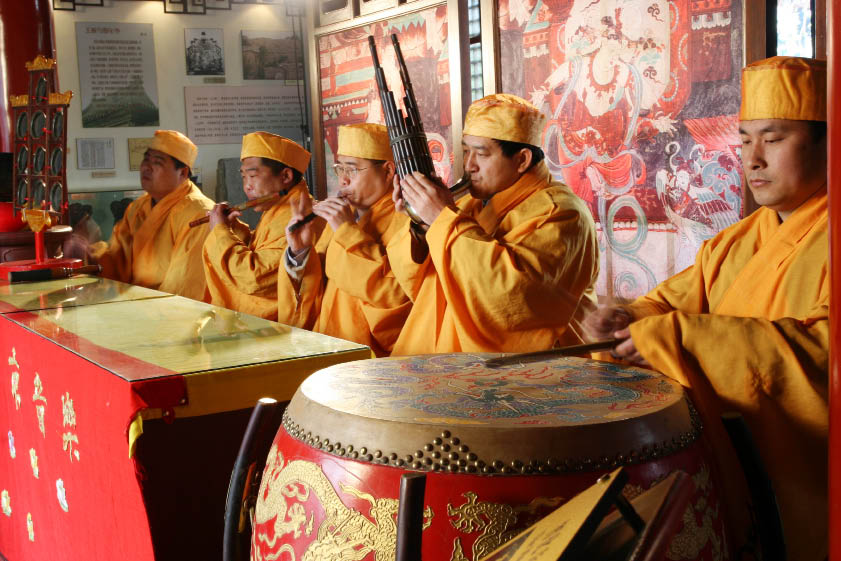Living Music Fossil in an Ancient Temple
By staff reporter XING WEN
|

|
|
The monk band at Zhihua Temple gives regular performance of the ancient Beijing music. China Foto Press |
LOCATED in the heart of Beijing, Zhihua Temple is an oasis of tranquility in this busy metropolis. It is not only the largest existing temple complex from the Ming Dynasty (1368-1644) in Beijing, but also the home of some priceless cultural heritages, including China's oldest style of music, elegant Buddhist sculptures, and exquisite frescoes.
Zhihua Temple was originally an ancestral temple of Wang Zhen, a eunuch who served the Ming Dynasty Emperor Yingzong when he was still a young crown prince. After the prince ascended the throne, Wang Zhen became his most trustworthy assistant and was appointed to take charge of affairs of the royal family.
Wang Zhen abused the emperor's trust and became increasingly powerful and influential at the imperial court, and he built mansions and ancestral temples for his family with embezzled money. Commissioned by Wang in 1443, Zhihua was one of these family temples and was given its name, meaning "Buddha brings salvation to the universe," by the emperor himself.
The roofs of black glazed tiles on the main buildings of Zhihua Temple, a rare sight on existing ancient temples in China and only produced in royal kilns, are testament to the emperor's partiality to Wang Zhen and his privileged status at court. After Wang's death in 1449, Zhihua Temple was converted into a Buddhist place of worship and has remained so ever since.
The rotating scripture cabinet in the Hall of Scripture stands out among the antiquities. Rotating scripture cabinets first appeared in China around 1,000 years ago. They were designed for illiterate Buddhists and function as prayer wheels used by Tibetan Buddhists. The cabinets are used to store scriptures, and, though called "rotating," can be fixed. They symbolize the Wheel of Dharma, also known as the Wheel of Law, which represents the Buddha's teaching of the path to enlightenment. It is believed that rotating or circling such a wheel will have the same meritorious effect as reciting the prayers and will bring the follower closer to achieving enlightenment.
The rotating scripture cabinet at Zhihua Temple, the oldest of the three remaining cabinets in Beijing, is fixed on a marble base and holds the scriptures of Tripitaka in 45 wooden drawers. To increase good karma and achieve a balanced mind, a pious believer must walk clockwise around the cabinet, mimicking the movement of the sun as it crosses the sky, and, to increase the effectiveness of the performance, focus his mind to express his faith.
Another attraction lies in the Hall of Tathagata, the biggest building in the temple complex. Stepping onto the second floor in the rear of the hall, one cannot help but be amazed by the decorations on the walls. More than 9,900 Buddha sculptures are enshrined in niches, giving the hall the name of Tower of Ten Thousand Buddhas.
Another visual wonder can be found in the Hall of Zhihua. A three-meter-high, 4.7-meter-wide Ming Dynasty fresco depicts the scene of Ksitigarbha Bodhisattva, one of the four leading gods in Buddhism who vowed that as long as there was still one suffering soul in hell, he would not attain enlightenment, with six eminent monks preaching Buddhism. The thoughtful composition, vivid facial expressions and brightly colored robes reflect the craftsmen's extraordinary painting skills and rich imagination.
| 